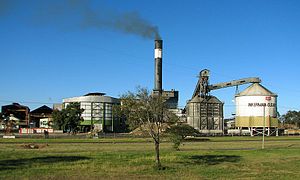Sugarcane mill: Difference between revisions
m Reverted edit(s) by 115.240.124.121 identified as test/vandalism using STiki |
|||
| Line 49: | Line 49: | ||
[[fr:Moulin à canne à sucre]] |
[[fr:Moulin à canne à sucre]] |
||
[[hr:Mlin za šećernu trsku]] |
|||
Revision as of 08:08, 9 September 2012

A cane sugar mill is a factory that processes sugar cane to produce raw or white sugar.
Processing

Traditionally, sugarcane processing requires two stages. Mills extract raw sugar from freshly harvested cane, and sometimes bleach it to make "mill white" sugar for local consumption. Sugar refineries, often located nearer to consumers in North America, Europe, and Japan, then produce refined white sugar, which is 99 percent sucrose. Sugar processing may lead to a dust explosion, which necessitates the use of non-sparking tools in many sugar mills.[1] These two stages are slowly merging. Increasing affluence in the sugar-producing tropics increased demand for refined sugar products, driving a trend toward combined milling and refining.
Milling

Small rail networks and trucks are common methods of transporting cane to a mill. Newly arrived cane is tested for sugar content and trash percentage.
The mill washes, chops, and uses revolving knives to shred the cane. Shredded cane is repeatedly mixed with water and crushed between rollers in the milling tandem; the collected juices contain 10-15 percent sucrose.
Energy in the sugar mill
The remaining fibrous solids, called bagasse, are burned for fuel in the mill's steam boilers. These boilers produce high-pressure steam, which is passed through a turbine to generate electrical energy (cogeneration).
The exhaust steam from the turbine is passed through the multiple effect evaporator station and it is used to heat vacuum pans in the crystallization stage as well as for other heating purposes in the sugar mill.
Bagasse makes a sugar mill more than energy self-sufficient; surplus bagasse goes in animal feed, in paper manufacture, or to generate electricity for sale.
Further processing

The cane juice is next mixed with lime to adjust its pH to 7. This mixing arrests sucrose's decay into glucose and fructose, and precipitates some impurities. The mixture then sits, allowing the lime and other suspended solids to settle. The clarified juice is concentrated in a multiple-effect evaporator to make a syrup of about 60 percent sucrose by weight. This syrup is further concentrated under vacuum until it becomes supersaturated, and then seeded with fine sugar crystals. A batch type sugar centrifuge separates the sugar crystals from the mother liquor. These centrifuges have a capacity of up to 2,200 kg per cycle. [2] The sugar from the centrifuges is dried and cooled and then stored in a silo or directly packed into bags for shipment.

The mother liquor from the first crystallization step (A-product) is again crystallized in vacuum pans and then passed through continuous sugar centrifugals. The mother-liquor is again crystallized in vacuum pans. Due to the low purity the evapo-crystallization alone is not sufficient to exhaust molasses, and so the so-called massecuite (French for “boiled mass”) is passed through cooling crystallizers[3] until a temperature of approx. 45 °C is reached. Then the massecuite is re-heated in order to reduce its viscosity and then purged in the C-produced centrifugals. The run-off from the C-centrifugals is called molasses.
The spun-off sugar from the B-product and C-product centrifugals is re-melted, filtered and added to the syrup coming from the evaporator station.
Raw sugar is yellow to brown. Bubbling sulfur dioxide through the cane juice before evaporation bleaches many color-forming impurities into colorless ones. This sulfitation produces sugar known as "mill white", "plantation white", and "crystal sugar". Such sugar is the most commonly consumed in sugarcane-producing countries.
Back-end refineries
Some cane sugar mills have so-called back-end refineries. In this case, a portion of the raw sugar produced in the mill is directly converted to refined sugar with a higher purity for the local consumption, for exportation or for bottling companies.
Factory automation in cane sugar mills
As in many other industries factory automation has been promoted heavily in sugar refineries in recent decades. The production process is generally controlled by a central process control system, which directly controls most of the machines and components. For security reasons only certain special machines, such as the centrifuges in the sugar house, are decentralized. In these cases PLCs are used.[4]
